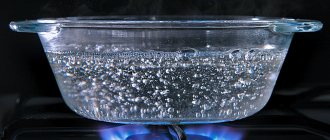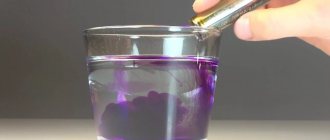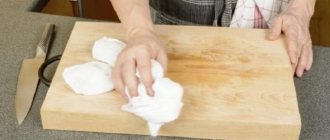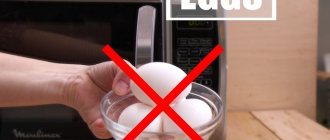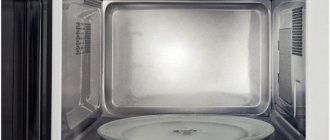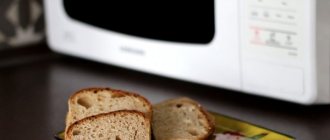Trying to save money, housewives often resort to methods they themselves invented. One of these is sterilizing a kitchen sponge in the microwave. It is believed that this procedure destroys all microorganisms that remain in the porous material, and, accordingly, extends the service life of the sponges. Let's try to figure out whether this is really so and whether any processing is needed at all.
Why sterilize a kitchen sponge?
It would seem that if you conduct a large-scale laboratory study, then the least amount of bacteria can be found on a kitchen sponge. Firstly, she is touched only with clean hands, and secondly, she is constantly “washed”. However, this is a mistaken impression.
Microbiota colonies
Microbes and bacilli reach the sponge in different ways.
- Primary contamination occurs at the production stage - microorganisms that live in the air and are on the surface of factory equipment penetrate into the pores of the foam rubber. However, this is not scary, because there are exactly the same invisible roommates in every house and apartment.
- Subsequently, bacteria are introduced inside during washing of utensils that were used for cutting raw meat or fish. No less dangerous are utensils that have been in contact with raw dairy products purchased at spontaneous markets.
- Also, some bacteria come from leftover food, especially if they have begun to decompose.
- If one of the family members has infectious diseases transmitted by airborne droplets, pathogenic microbes remain on the plates and cutlery, which subsequently penetrate into the porous material of the sponge and can begin to reproduce.
During a study conducted by scientists from the University of Furtwagen (Germany), 362 types of bacteria were found on kitchen sponges. This is even more than on a toilet brush.
Other microorganisms
In addition to bacteria, yeast and mold fungi live and feel free in the thickness of the foam rubber. Depending on what types of fungi have colonized the sponge in a particular case, they can be much more dangerous than other microorganisms. In addition, they are incredibly difficult to fight, and when they enter the body, many types of mold (for example, the notorious Aspergillus) cause irreversible changes, even lethal.
We recommend: How to disinfect money from coronavirus - simple and quick ways
Top 3 best household chemicals
When choosing industrial cleaning products for microwave ovens, the following criteria are important:
- efficiency;
- safety (quality of the lid, content of phosphates, chlorine and other harmful components);
- price;
- effects on the skin of the hands;
- smell.
The most effective and safest means are:
- Sano Forte Plus
- Green&Clean Professional,
- Synergetic and Cillit Bang Anti-grease.
Green&Clean Professional
Green&Clean Professional microwave oven cleaner helps to quickly remove grease and carbon deposits from the internal surfaces of the device.
It has the following advantages:
- Designed specifically for microwave ovens, but also suitable for gas stoves.
- Has an antibacterial effect.
- Deals with old stains.
- Suitable for all surfaces.
- Slowly consumed due to the high concentration of components.
The disadvantages include:
- The presence of phosphates in the composition.
- High cost.
Price - 500 rub.
Synergetic for slabs
Synergetic for cookers is an environmentally friendly product for quickly cleaning kitchen appliances.
Its advantages include:
- composition safety;
- quick removal of greasy stains;
- mild odor;
- low cost.
The disadvantages of the product are that it has a strong effect on the skin, despite the environmentally friendly ingredients. Price - 150 rub. Read reviews here, here and here.
Cillit Bang
Cillit Bang Anti-grease and Shine is suitable for most kitchen surfaces:
- apron,
- slabs,
- Microwave ovens, etc.
It has the following advantages:
- Suitable for everyday and general cleaning.
- Does not damage surfaces.
- Quickly cleanses old fat.
- Available at most hardware stores.
The disadvantages include:
- Strong smell.
- Severe dry skin if exposed without gloves.
Price — 180 rub. Read reviews here, here and here.
Sterilizing sponges in the microwave
To kill the pathogenic microflora that lives inside the dishwashing sponge, housewives use a very simple method - processing in the microwave. This procedure is carried out once every three days or more often if necessary.
Process description
Before proceeding directly to sterilization, the sponge is “washed” with dishwashing detergent or simple laundry soap. This is not necessary in order to remove some of the microbes mechanically, but in order to wash out the remaining food from the pores. If you place a sponge in the microwave without first cleaning it, it will acquire a persistent unpleasant odor (in this case it will have nothing to do with the activity of bacteria).
The next steps look like this:
- The sponge is soaked in clean water. The more liquid the material absorbs, the higher the chance that everything will go according to plan and that you will not have to buy a new microwave oven.
- The sponge is placed on a plate (it should be ceramic, glass or made of special plastic).
- A cup two-thirds filled with water is placed next to the sponge - this is a precaution designed to prevent the accumulation of unused magnetic energy inside the device.
- Turn on the microwave for 1–2 minutes. It is advisable to set the power to 750 Watts or more.
- When the oven turns off, you need to wait until the sponge has cooled down a little, since its temperature will be 100°C, and only then remove it and put it back in place.
During sterilization, do not leave the microwave. Despite the fact that the water with which the sponge is soaked protects it from melting, sometimes the foam rubber still begins to “melt” - in this case, you should immediately turn off the heating.
Of course, you should not treat metal scrapers in this way - sparks will appear inside the microwave.
Advantages and disadvantages
Housewives who have used a microwave for sterilization not for the first time have already appreciated the advantages of this method:
- unlike sterilization “the old fashioned way”, the method takes a minimum of time;
- disinfecting sponges or kitchen rags with high temperature is more effective than hand washing or washing;
- glassware and tempered ceramics can withstand the process without problems.
There are also disadvantages:
- oven capacity is limited. For example, only one three-liter jar fits in an “average” microwave;
- Do not place dishes with metal elements in the microwave!
Is there an effect?
Some people who are unfamiliar with the operating principles of a microwave oven endow this device with truly fantastic qualities. Unfortunately, this is just a heating device, and its effect on microflora is exaggerated. In essence, the process described above imitates steam sterilization - it has a detrimental effect on most microorganisms known to science.
We recommend: How to sew a mask without a sewing machine in 2 minutes
However, this effect is achieved not only and not so much due to the presence of steam. The heating temperature is of great importance - if water boils at 100°C in a microwave, then in an autoclave the thermometer shows no lower than 130°C. The processing time also differs - a kitchen sponge spends several minutes in the microwave, while sterilization in an autoclave takes at least half an hour.
It turns out that such a short-term treatment in a microwave oven can kill only the least resistant microbes. They, as a rule, do not pose any danger to humans and are part of the natural microflora.
Consequences of sterilization
Housewives, sterilizing a kitchen sponge in the microwave, hope that this will protect them from pathogenic microflora and the diseases caused by it. In fact, the degree of risk increases - since weak microbes did not survive the steam treatment, space was freed up inside the pores, which was immediately occupied by stronger and more dangerous microorganisms.
In most cases, a sponge removed from the microwave is stored in the same place where it was before, that is, in close proximity to the sink. There, bacteria receive an ideal environment for reproduction, because they are warm and humid, which means that after just a couple of hours, a seemingly harmless piece of colored foam becomes a household bacteriological weapon.
How to wash away old stains?
The following folk remedies are used to remove old fat and stubborn stains:
Soda and hydrogen peroxide .
Both components are diluted to a paste and applied to particularly severe stains. Peroxide is also added to soap foam to enhance its effect. In addition to grease and carbon deposits, hydrogen peroxide also helps to cope with yellowing of the rubber door seal.- Ammonia . A solution of 200 ml warm water and 2-3 tbsp. Ammonium hydroxide helps to quickly remove grease and carbon deposits, but this method requires careful odor removal. To remove the most stubborn stains, you can apply a 40% ammonia solution to them and leave for 5-6 hours.
- Windshield wiper . Glass cleaners contain alcohols, so they dissolve even stubborn layers of grease well. To wipe the walls of a microwave oven, it is recommended to use only diluted solutions (1:2 or 1:1 with water).
- Chlorine (“Whiteness”, etc.) . Chlorine-containing products are used to remove dark plaque and stains on enamel. To clean, you need to dissolve 20-30 ml of “Whiteness” in 1.5-2 liters of water, moisten the sponge and rub gently. It is prohibited to clean damaged surfaces and stainless steel with chlorine.
Regular cleaning with strong solutions can damage the protective layer on the chamber walls. To remove dried grease stains and carbon deposits, it is recommended to use industrial products for microwave ovens.
How to properly treat a sponge?
To disinfect a kitchen sponge, it should be soaked in a 20% solution of sodium hypochlorite (popularly called bleach), and then processed in an autoclave. However, it is unlikely that foam rubber will withstand such abuse, and the cost of the procedure will be several times higher than the price of a new clean sponge. Therefore, you should not sterilize at home - it is better to simply throw away the used item.
Whether to continue sterilization in the microwave after reading this article is up to everyone to decide for themselves. However, you should never forget that the price of a piece of foam rubber and human health are incomparable.
When should a sponge be disposed of?
There will come a time when you should just throw away the sponge. Two weeks is the maximum life expectancy for a typical housewife's kitchen assistant.
Replacing it regularly, at least every 14 days, will prevent the spread and growth of bacteria. You should also disinfect or replace the sponge if it smells funny.
According to experts, cleaning kitchen sponges does not actually get rid of bacteria 100%. It may be better to simply replace them every week than to try to give them a second life.
Found a violation? Report content
Useful tips
keep the inside of your microwave oven clean :
- Wipe the inner walls with a damp cloth or sponge at least once every 2 days.
- After each use of the grill or long-term stewing, use the self-cleaning function or preheat the microwave oven with a soda solution.
- For persistent stains, steam the chamber with a soda solution, and then wipe and treat the walls with an industrial microwave cleaner.
- If the device is used frequently, carry out general cleaning at least once a month.
It is recommended to wash the inner chamber from top to bottom: first the grille and top wall, then the back, sides and bottom, and lastly the door.
Precautionary measures
When cleaning a microwave oven, there are several rules to follow:
- do not use metal or hard abrasive powders;
- do not clean the enamel with solutions of citric and acetic acid, and when using citrus products, do not heat the container for longer than the recommended time (3-5 minutes);
- during the washing process, avoid getting large amounts of moisture and foam into the holes in the walls of the oven;
- apply sprays and liquids for cleaning stoves on a rag or sponge, and not directly on the walls;
- Do not treat the inside of the microwave with a melamine sponge;
- After cleaning the microwave, warm up a container with water or a weak infusion of dry zest, and then wipe the walls with a damp cloth to remove any remaining detergent.
Before washing, you must remove the ring and plate. The latter can be treated with any grease remover or glass cleaner.
Antiseptic treatment
Protective dressings can only be disinfected with alcohol-based antiseptics with a concentration of 60% or more. Suitable:
- formic alcohol;
- boric alcohol;
- pepper tincture;
- "Aseptolin"
You can make your own antiseptic.
To watch the video:
How to make liquid to disinfect masks
Disinfectants that can destroy coronavirus must contain alcohol with a concentration of at least 60%. Ingredients for preparing the disinfectant solution:
- ethyl alcohol 96% - 80 ml;
- glycerin - 15 ml;
- hydrogen peroxide - 5 ml.
Mix everything and pour into a bottle or spray bottle. Wipe PPE on both sides as necessary.
Vodka-based antiseptics are ineffective, since the alcohol concentration is only 40%. Various mixtures based on aromatic oils are also ineffective.
Ideal habitat and breeding place
Sponges are usually moist, stored in a warm place, have a fairly large surface area and can contain a lot of nutrients for microbes - leftover food, for example.
Bacteria don't just survive
- they thrive in this environment and can spread to your work surface and utensils that you think have been washed well.
spread during cleaning , according to Phillip Delekta, a professor of microbiology at Michigan State University in East Lansing.
.
Can disposable masks be washed?
According to the current Sanitary Regulations, disposable protective equipment is not allowed to be disinfected for reuse. The surgical mask is made of non-woven material, which is easily destroyed by washing and steam treatment. They should be discarded after two hours of wear.
But in times of shortage, disposable PPE can be disinfected to be used for shopping or when caring for a sick family member. Acceptable methods of treatment are wiping with an antiseptic, ironing, and ultraviolet irradiation.
You can wash a disposable mask only once. After the second wash, the non-woven material unravels and the PPE becomes unusable.
To watch a video about processing a disposable mask:
Washing machine
The sponge can also be washed in the washing machine. Place the sponge in the washing machine along with other items and set the wash temperature to the highest setting. This method will be even more effective if you add bleach.
If you keep your sponges clean, they will last longer. However, even clean sponges wear out over time. To keep your home always clean and your household healthy, make sure that the sponges are completely dry before the next use and regularly replace them with new ones.
The article was translated and revised from Hunker.com
